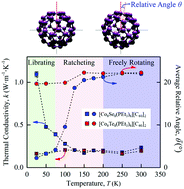Fullerene rotational dynamics generate disordered configurations that suppress thermal conductivity in superatomic crystals†
Abstract
The thermal conductivity of fullerene-based superatomic crystals (SACs) is investigated using molecular dynamics simulations. The temperature-dependent predictions agree with the trends of previous measurements. The thermal conductivity behavior emerges as a result of the C60 molecule rotational dynamics and orientation, which are quantified using the root mean square displacements of the carbon atoms and the relative orientations of the C60s. At low temperatures, the C60s exhibit small rotations around equilibrium positions (i.e., librations). When the librating C60s are orientationally-ordered, as in the [C60] and [Co6Se8(PEt3)6][C60]2 SACs, thermal conductivity decreases with increasing temperature, as is typical for a crystal. When the librating C60s are orientationally-disordered, however, as in the [Co6Te8(PEt3)6][C60]2 SAC, thermal conductivity is lower and temperature independent, as is typical for an amorphous solid. At higher temperatures, where the C60s in all three SACs freely-rotate and are thus dynamically disordered, thermal conductivity is temperature independent. The abrupt changes driven by the C60 dynamics suggest that fullerene-based SACs can be designed to be thermal conductivity switches based on a variety of external stimuli.



 Please wait while we load your content...
Please wait while we load your content...
